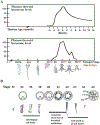Steroid-receptor coactivator complexes in thyroid hormone-regulation of Xenopus metamorphosis
- PMID: 37717995
- PMCID: PMC11274430
- DOI: 10.1016/bs.vh.2023.02.003
Steroid-receptor coactivator complexes in thyroid hormone-regulation of Xenopus metamorphosis
Abstract
Anuran metamorphosis is perhaps the most drastic developmental change regulated by thyroid hormone (T3) in vertebrate. It mimics the postembryonic development in mammals when many organs/tissues mature into adult forms and plasma T3 level peaks. T3 functions by regulating target gene transcription through T3 receptors (TRs), which can recruit corepressor or coactivator complexes to target genes in the absence or presence of T3, respectively. By using molecular and genetic approaches, we and others have investigated the role of corepressor or coactivator complexes in TR function during the development of two highly related anuran species, the pseudo-tetraploid Xenopus laevis and diploid Xenopus tropicalis. Here we will review some of these studies that demonstrate a critical role of coactivator complexes, particularly those containing steroid receptor coactivator (SRC) 3, in regulating metamorphic rate and ensuring the completion of metamorphosis.
Keywords: Chromatin remodeling; Histone modification; Intestine; Stem cell; Thyroid hormone receptor; Xenopus laevis; Xenopus tropicalis.
Copyright © 2023 Elsevier Inc. All rights reserved.
Figures




Similar articles
-
Essential and subtype-dependent function of thyroid hormone receptors during Xenopus metamorphosis.Vitam Horm. 2023;123:503-523. doi: 10.1016/bs.vh.2023.02.004. Epub 2023 Mar 25. Vitam Horm. 2023. PMID: 37717996 Free PMC article. Review.
-
Functional Studies of Transcriptional Cofactors via Microinjection-Mediated Gene Editing in Xenopus.Methods Mol Biol. 2019;1874:507-524. doi: 10.1007/978-1-4939-8831-0_29. Methods Mol Biol. 2019. PMID: 30353533 Free PMC article.
-
Unliganded thyroid hormone receptor regulates metamorphic timing via the recruitment of histone deacetylase complexes.Curr Top Dev Biol. 2013;105:275-97. doi: 10.1016/B978-0-12-396968-2.00010-5. Curr Top Dev Biol. 2013. PMID: 23962846 Free PMC article. Review.
-
Histone methyltransferase Dot1L is a coactivator for thyroid hormone receptor during Xenopus development.FASEB J. 2017 Nov;31(11):4821-4831. doi: 10.1096/fj.201700131R. Epub 2017 Jul 24. FASEB J. 2017. PMID: 28739643 Free PMC article.
-
Thyroid hormone receptor subtype-specific function in controlling organ-specific developmental timing and rate during Xenopus development.Front Endocrinol (Lausanne). 2025 Jun 9;16:1614439. doi: 10.3389/fendo.2025.1614439. eCollection 2025. Front Endocrinol (Lausanne). 2025. PMID: 40551888 Free PMC article. Review.
Cited by
-
Functions and Mechanism of Thyroid Hormone Receptor Action During Amphibian Development.Endocrinology. 2024 Sep 26;165(11):bqae137. doi: 10.1210/endocr/bqae137. Endocrinology. 2024. PMID: 39397558 Free PMC article. Review.
-
Intestinal remodeling during Xenopus metamorphosis as a model for studying thyroid hormone signaling and adult organogenesis.Mol Cell Endocrinol. 2024 May 15;586:112193. doi: 10.1016/j.mce.2024.112193. Epub 2024 Feb 22. Mol Cell Endocrinol. 2024. PMID: 38401883 Free PMC article.
References
-
- Buchholz DR (2015). More similar than you think: Frog metamorphosis as a model of human perinatal endocrinology. Developmental Biology, 408, 188–195. - PubMed
-
- Buchholz DR, Paul BD, Fu L, & Shi YB (2006). Molecular and developmental analyses of thyroid hormone receptor function in Xenopus laevis, the African clawed frog. General and Comparative Endocrinology, 145, 1–19. - PubMed
Publication types
MeSH terms
Substances
Grants and funding
LinkOut - more resources
Full Text Sources
Miscellaneous

